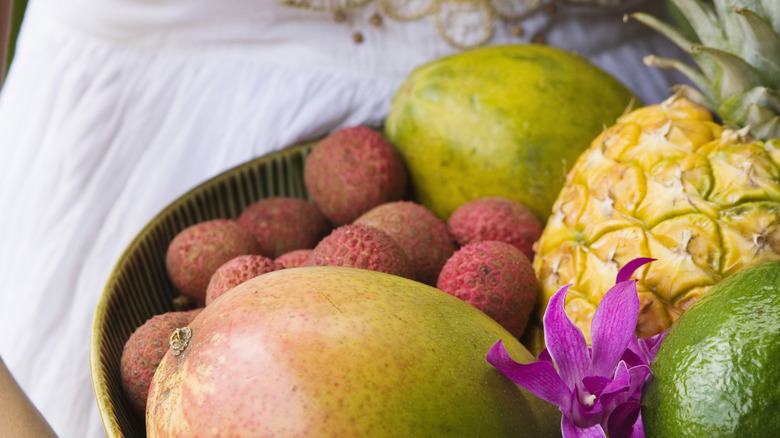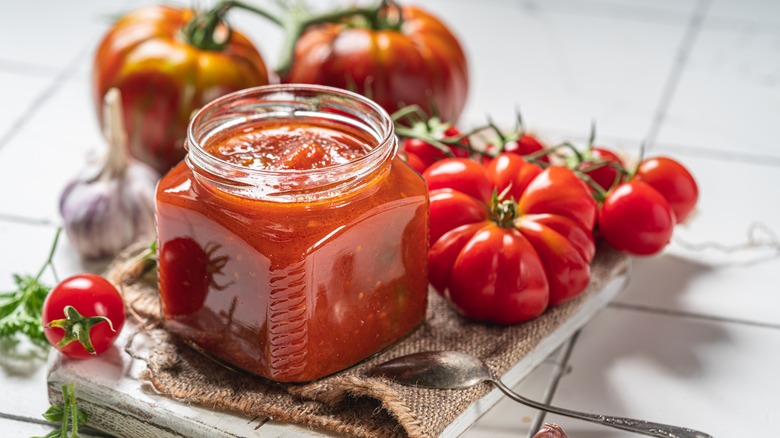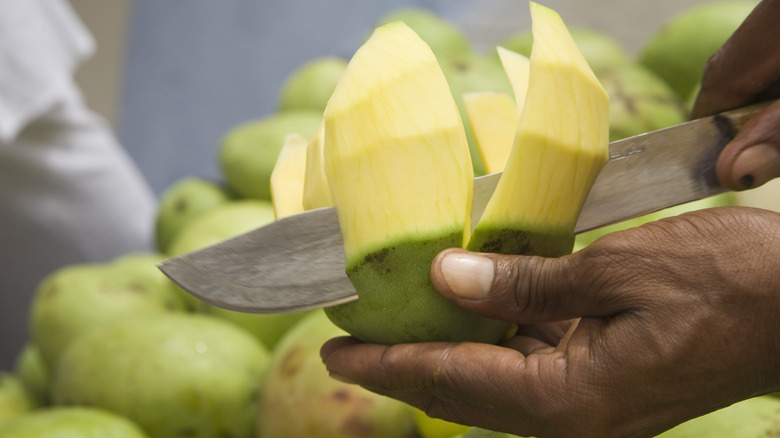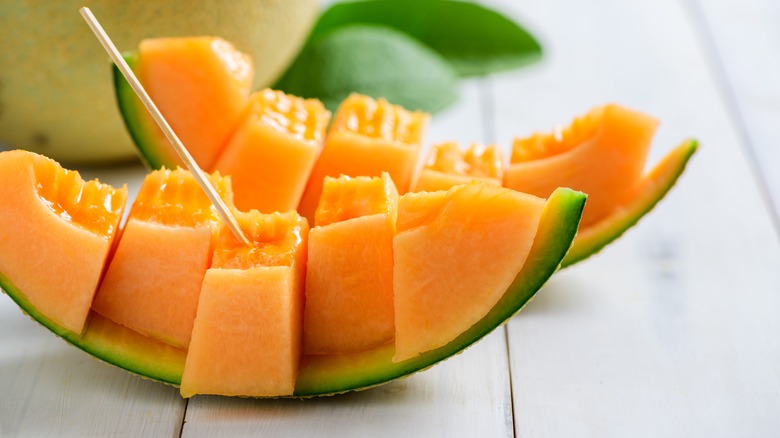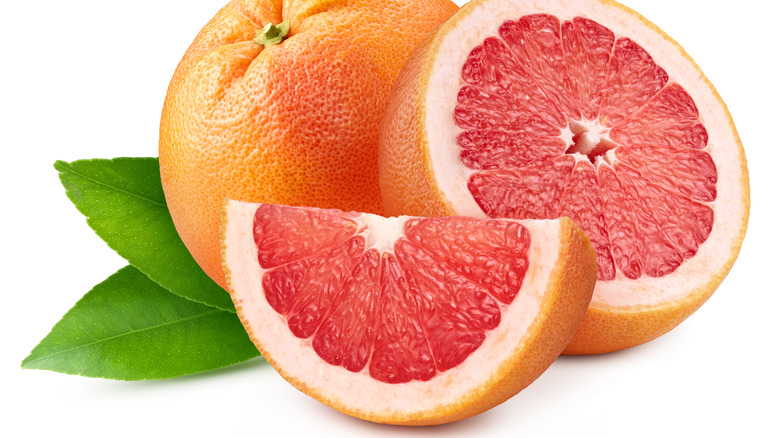11 Fruits You Should Be Seasoning With Salt
It's great to add a little salt to fruit, within reason. Salt brings out the natural flavor of the fruit and can help counteract overly bitter or sour notes. Salting certain fruits may help you to enjoy more of those plant foods, some of which you might otherwise wince at. But remember, Dietary Guidelines suggest limiting your sodium intake to 2300 milligrams per day. You may enjoy a sprinkle or two if you choose to season your fruit, but don't go crazy with the saltshaker.
Interestingly, as little as 5% of your sodium intake may be coming from your saltshaker, according to a 2017 study in Circulation. The bulk of your sodium intake comes from processed convenience foods and restaurant fare. Thus, you may benefit by swapping a serving of potato chips (between 170 milligrams and 185 milligrams of sodium per ounce) for a thick slice of (lightly) salted watermelon. You'll get the nutritional benefits of plant food and you can control how much salt you use. Fruit is also a good source of blood pressure-regulating potassium (via CDC).
To put things in perspective, one shake of salt is around 1/32 of a teaspoon (via Taste of Home). As one teaspoon of salt contains an average of 2360 milligrams of sodium (via USDA). That's about 70 milligrams of sodium per shake. And you don't need much more than a shake or two. If you use a seasoning blend of salt and spices one shake will have even less sodium.
1. Tomato
Fresh, ripe tomatoes from the garden may taste incredibly delicious. But you can intensify their flavor even more by salting them. As for those supermarket tomatoes that have little to no flavor, salting will make them more than just a watery bite of flesh and seeds. And here's why: Adding salt will draw water out of the fruit via a process called osmosis, leaving it more concentrated with tomatoey goodness (via Insider). Furthermore, salting stimulates your salivary glands, which can help reduce any bitterness — and in essence, deliver a sweeter taste perception to your mouth.
For a savory treat, try our Heirloom Tomato Salad recipe. It's got some bitter notes from olive oil, an earthy sweetness from basil, and a sour tang from vinegar. Flaky sea salt brings it all together for a pleasant balance of flavor. In fact, salt is a tiny (but mighty) component that can bring a variety of flavors together for a more well-rounded, palate-friendly appeal (via Science ABC).
2. Green mango or guava
Salt is perfect for unripened fruits, particularly green mango or guava. An unripe fruit won't taste very sweet; in fact, they are often a bit sour on the palate. So why eat them? Unripened fruits contain a higher amount of resistant starch and fiber, both of which can benefit your gut (via Her Zindagi). And they offer a crisp, light crunch — one of the reasons Thai, Indian, and Hawaiian cultures may enjoy them seasoned with a salty seasoning blend (via News Press). According to chemist Martin Lersch of Khymos, Taiwanese people enjoy unripe guava with a sprinkling of plum powder (which contains salt). In Hawaii, unripe guava may be served with soy sauce and vinegar (and perhaps a bit of sugar). And people in Pakistan and India enjoy guava fruit with a combination of cayenne, masala, and salt. The common denominator here is the salt factor (soy sauce is salty).
Salt can make immature fruits more tantalizing to the tastebuds. So, if you've decided to go "green," adding a little salt to your not-so-ripe mango or guava will give it a sweeter appeal and tone down the sour bite. Salt can also play well with ripe mango, like in this easy mango salsa recipe from Tasting Table. It will brighten the dish and enhance all the flavors for a sweet, zesty, and tangy combo.
3. Papaya
When it comes to papaya, the distinctness of this tropical fruit can mean very two different things. It can either be appealing, or absolutely appalling. What's your stance? If you side with the latter (and liken it to smelly feet), the remedy may be quite simple.
Turns out the papain enzyme, which is nutritious (and highly concentrated in papaya) gives off an unpleasant odor. To get the value of papaya's nutrition as well as its colorful and starchy textural appeal, a squeeze of lime can be your aide in mitigating this issue. And, since salt and citrus have similar effect on the tastebuds to make food more appealing (via Seattle Times), why not use a sprinkle of salt on your papaya instead of (or in addition to) the lime? Give it a try and see what it does. If anything, it will enhance the fruit's sweetness.
Funnily enough, raw unripe papaya may have no off-putting stench. In fact, it can be mild and almost tasteless, according to Cook's Illustrated. But a little salt along with some sour, sweet, and/or spicy ingredients can make it taste delicious. In fact, in Thai cuisine, it is used shredded and flavored with bold seasonings, such as chili, lime, and fish sauce. So shred it and dress it using some salt in your seasoning. Or go ahead and pickle it, using salt for a brine.
4. Cantaloupe or honeydew
Prosciutto and melon make a delightful combination — one that tickles the taste buds with a delightful savory-sweetness. What makes it work is that the thin slice of cured ham is quite salty, drawing out the sweetness of the melon (via Khymos). This concept is not new.
In fact, the origins of eating cured meat with fruit lie in ancient Roman times. The combination was thought to boost the immune system (via Eataly). Ancient medicinal humorism was a system based on balancing the elements of fire, earth, air, and water to sustain good health. In those times eating the fruit alone was considered more of a health hazard due to its cold and wet nature (via Italian Notes). But pairing it with a dry, warm food such as a cured meat made it safe to eat. It wasn't until centuries later that the father of modern Italian cuisine, Pellegrino Artusi, came up with the combo of prosciutto e melone (via Eataly). Its popularity didn't surge until the 1960's when the salty fruit combo became a highlight for summer Italian meals.
If you don't eat ham or don't have slices of thin cured meat, try sprinkling a little salt on your cantaloupe or honeydew instead. In fact, Tasting Table suggests adding a rim of salt (or even just a pinch) to your melon cocktails to enhance the fruit's sweetness.
5. Strawberries
As a kid, you may have liked cutting the tops off of strawberries and filling each well with sugar to make them even sweeter. And you may be tempted to do the same now, especially if your batch has a lackluster flavor (or is closer to tart than sweet). Such is the case when you get them out of season. But when you eat them straight from the fields, ripe and in season, those strawberries will be at their optimal sweet peak. You may also enjoy a great bang for your tastebuds when your local farmer's market features them.
But, for those of us whose strawberries may be lacking in flavor or sweetness (perhaps because they're out of season or picked a bit early), you need not roll them in sugar or add any sweetener, for that matter. Consider adding a hint of salt instead. Salt will draw out the berry's natural sweetness.
6. Peaches
Oh, the pleasure of summer and juicy, ripe peaches. Though these days, you can enjoy peaches all year long. Sure, in-season peaches are the most delightfully sweet, especially when they are ripe. But if you'd like to get the best of their flavor at any time and in any season, slice them thinly and sprinkle them with some flakey salt (via My Recipes). But don't just salt and eat them. The trick is to let them sit salted for a little while. Just enough time to sweep the floor, wipe the counters, and maybe wash a few dishes. We're talking 10 minutes, tops. The salt needs this time to draw out the liquid, which turns your peaches into intense flavor bombs.
For a savory-sweet indulgence, try Market Restaurant's roasted peach recipe at Tasting Table. It uses not one, but three forms of salt (well, if you count the salty pancetta). Peaches are roasted with olive oil, pepper, and kosher salt, and tossed with arugula, crispy pancetta, and a shallot vinaigrette. The final dish is topped off with a drizzle of sage oil that's brightened with fleur de sel (sea salt harvested from France).
7. Pineapple
There are other reasons to salt fruit beyond enhancing the sweetness or balancing out the bitterness. It may even save your mouth from an unpleasant sensation that can be triggered by certain fruits.
Perhaps you've bitten into a juicy, ripe pineapple and found that it to cause a tingly sensation (or even a slight burn). It's the bromelain enzyme in the pineapple that may be responsible (via Eating Well). Bromelain brakes down proteins, which is beneficial for digestion (via Hum Nutrition). But unfortunately, this very same enzyme may cause some oral irritation.
The solution: Soak your pineapple in saltwater before eating it. Seasoning your pineapple in a saline solution will neutralize the bromelain, so by the time you bite into that juicy chunk, its burning affect will be nulled. Don't soak it too long, however, or it may water down the delightful sweet tang of the fruit and ruin its texture. In fact, research suggests you need only a teaspoon of salt per one cup of water for a 30-second soak (via Inverse).
8. Grapefruit
Grapefruit is a good source of phytonutrients including fiber and vitamins A and C (via USDA). But it's no surprise that grapefruit can be quite bitter (and thus hard to consume without the complement of a sweetener). And we are not just talking about the pith. Segmenting those wedges can help remove some of their bitterness. But the flesh itself can still hold onto plenty of tartness, thanks to its abundance of a bitter compound called naringin, per NPR. So for those who desire its tart, citrusy flavor but need to sweeten the deal, there's a way to forgo the sugaring habit. Go for a hint of salt, instead.
In fact, salting your grapefruit is not a new concept. It was recommended by an advice columnist back in the early 1900s to tone down its bitterness. In 1946, a Life magazine ad campaign purported that (Morton) salt could make your grapefruit sweeter. And, yes there is science to back both those claims. According to a 2011 review in Nutrients, salt suppresses bitterness, which can ultimately enhance the sensation of a fruit's sweetness. For those who love grapefruit but intend to kick their sugar habit, rest assured you can still enjoy that grapefruit — just swap out those spoonfuls of sugar for a sprinkling of salt, instead.
9. Durian
Durian is a musty, pungent-smelling tropical fruit native to Indonesia (via The Market at Delval). So, why do some eat it? If you can get beyond the intense smell, it's a fruit that has an amazing complexity of flavor (via Cookist). In fact, for those who enjoy it, the stronger it smells, the more intensely it may taste. It's been described as having an eggy custard taste (with notes of vanilla and caramel) with a creamy cheesecake texture. And, although it may have some slightly bitter notes and an undeniably sulfurous smell of rotting onions, it is prized by some as one of the most delectable fruits.
If you're a curious gastronome but don't like that "rotten" smell, getting that durian into your mouth may be eased with the addition of salt. Sodium not only reduces bitterness and enhances sweetness, but it can also improve flavor overall (via Nutrients). According to Rojak Daily, durian fried rice (a sodium-containing dish) is a symphony of savory and spicy flavor with some sweetness from the durian. And just in case you were wondering, you can get this fruit in the U.S., as it is also grown in Hawaii.
10. Avocado
Avocado is a creamy and mild fruit. That's why it works so well in a smoothie — it doesn't affect the flavor but adds a rich nutrient density as a good source of both monounsaturated fats and fiber (it's got 10 grams of fiber per one medium avocado via USDA) — and thickens it nicely, too. But it can certainly use a little flavor punch if it's your key ingredient. Thus, seasoning your avocado is common whether you are enjoying it out of the skin, in your guacamole, or serving it up as avocado toast.
Salt is one of the easiest ways to season it. Salt and pepper is another easy go-to. Luckily these days, there are many accessible seasoning combos that contain the flavor-lifting salt — including the chili-lime-salt blend Tajín and Trader Joe's Everything But the Bagel seasoning. If you are looking for a simple (avocado) mash-up, try this quick and easy guacamole from Mashed. It's got cilantro and red onion as well as lime and sea salt to boost its overall flavor.
11. Watermelon
It may not be surprising that watermelon is hydrating. Its flesh is more than 90% water (via Mayo Clinic Health System). But that doesn't lessen the value of its nutrients. It contains vitamin A, vitamin C, and essential B vitamins, and is also a source of potassium — 170 milligrams for a cup of diced melon (via USDA). Its red color is derived from its abundance of lycopene — a powerful antioxidant that maintains healthy cells by reducing oxidative damage (via USDA Ag Research). All the more reason to enjoy this refreshing summer fruit.
While we expect each bite of watermelon to deliver a powerful juicy, sweetness, there are those times when the flesh isn't quite so sweet. It may even contain some bitter or sour notes (much of that is in the rind). To get more sweetness from your watermelon, just add a bit of salt. No sugar or sweetener is necessary. Salting your watermelon not only makes it taste sweeter, but also gives it a juicier texture.
